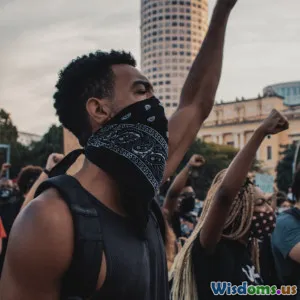
Rosa Parks Bold Move That Ignited a Nationwide Movement
7 min read Explore how Rosa Parks' courageous defiance sparked the civil rights movement and changed America forever. (0 Reviews)
Rosa Parks' Bold Move That Ignited a Nationwide Movement
Introduction
On December 1, 1955, an unassuming African American woman named Rosa Parks sat quietly on a bus in Montgomery, Alabama. What followed was a simple yet profound act of resistance: she refused to give up her seat to a white passenger—a demand rooted in the racist Jim Crow laws of the time. This courageous decision would ignite one of the most pivotal campaigns in American history—the civil rights movement. But beyond the iconic image of a woman sitting on a bus, lies a story of resilience, strategic planning, and community action that redefined social justice and equality in America.
The Historical Context: Segregation and the Jim Crow South
The 1950s American South was governed by Jim Crow laws that enforced racial segregation, institutionalizing systemic discrimination against African Americans in public spaces, education, employment, and transportation. Buses operated with a rigid racial hierarchy, where Black passengers were required to sit at the back or give up seats for white passengers.
Rosa Parks' arrest was not an isolated event but a representation of daily indignities suffered by Black Americans. However, the timing and her unyielding stance catalyzed a shift. The Black community in Montgomery was growing increasingly frustrated, seeking not only justice but dignity.
Who Was Rosa Parks?
Rosa Louise McCauley Parks was more than the tired seamstress often mythologized. She was an active member of the NAACP (National Association for the Advancement of Colored People) and deeply involved in civil rights advocacy well before 1955. Born on February 4, 1913, in Tuskegee, Alabama, Parks grew up contesting racial injustices, fueled by her mother’s influence and education.
Contrary to popular belief, Parks wasn’t merely physically tired but ‘‘tired of giving in’’. She was prepared to stand up—or rather sit down—for equality. This deliberate act of defiance was underpinned by a lifetime of activism and courage.
The Arrest and Legal Battle
When Parks refused to stand for a white passenger, the bus driver called the police, and Parks was arrested for violating the segregation laws. Her arrest was the spark needed to mobilize the African American community in Montgomery.
Her case became the focal point of a larger legal battle. The NAACP quickly recognized the opportunity to challenge segregation laws in court, which began a series of legal appeals highlighting the unconstitutionality of racial segregation.
The Montgomery Bus Boycott: A Community Rises
In response to Parks' arrest, African Americans in Montgomery organized the Montgomery Bus Boycott, a 381-day mass protest that showed remarkable coordination and sacrifice.
Leadership and Organization
The boycott was organized by a young pastor, Dr. Martin Luther King Jr., who emerged as a powerful new leader during this time. Along with other civil rights figures, they formed the Montgomery Improvement Association to sustain the movement.
Economic and Social Impact
African Americans made up about 75% of the bus system's ridership, and their refusal to use buses caused a severe financial strain on the transit system. People walked miles, carpooled, or found other means to avoid using segregated buses.
National Attention
The boycott drew national and international attention to the plight of Black Americans under Jim Crow laws, helping to galvanize public opinion and build momentum for civil rights legislation across the country.
The Supreme Court Ruling and Legal Victory
After prolonged legal battles and the boycott, the U.S. Supreme Court ruled in Browder v. Gayle (1956) that bus segregation was unconstitutional. This landmark decision legally ended segregation on public buses in Montgomery, setting a precedent to dismantle segregation elsewhere.
Legacy and Lasting Impact
A Symbol of Resistance
Rosa Parks became an enduring symbol of the power of peaceful resistance and civil disobedience. Her quiet strength inspired countless others to challenge injustice in myriad forms.
Fueling the Civil Rights Movement
The successful Montgomery Bus Boycott demonstrated the effectiveness of grassroots activism, nonviolent protest, and legal action. It spurred other major campaigns including sit-ins, freedom rides, and voter registration drives.
Honoring Rosa Parks
Parks received many honors during her lifetime, including the Presidential Medal of Freedom and the Congressional Gold Medal. Yet, her true recognition remains in the continued fight for equality and justice she helped initiate.
Insights and Reflections
Rosa Parks’ brave stand illuminates several crucial lessons:
- Courage is contextual: Individual acts become transformative only within a collective and strategic framework.
- Grassroots activism matters: The success of the boycott centered on community solidarity and persistence.
- Legal and social battles must go hand-in-hand: Changing unjust laws required both courtroom victories and mass mobilization.
Conclusion
Rosa Parks’ decision to remain seated wasn’t just a moment of defiance; it was a catalyst for a nationwide movement demanding dignity, equality, and opportunity. Her story reminds us how one individual’s courage, combined with the power of a united community, can dismantle systemic injustice. Today, her legacy continues to inspire ongoing struggles for civil rights worldwide, proving that even the simplest acts of bravery can indeed change the course of history.
“The only tired I was, was tired of giving in.” – Rosa Parks
Rate the Post
User Reviews
Popular Posts




















